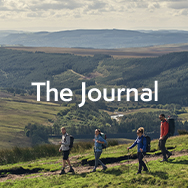Explore the beauty of Britain with ‘Discovering Britain’ walks
The world is so full of fascinating places, people and sights, that it’s sometimes easy to forget how much there is to explore on our own doorsteps. But Britain’s wonderful and wide-ranging landscapes all have a story to tell about both the past and the present.
‘Discovering Britain’ is an exciting series of geographically themed walks, created by the Royal Geographical Society (with IBG), that bring these stories alive and aim to inspire everyone to explore and learn more about Britain.
Alongside the Craghoppers-sponsored ‘Britain from the Air’ exhibition, these walks have been carefully chosen to tell a particular story about Britain’s landscape. They are designed to be fun, informative and inspiring and there are now more than 150 to choose from on the Discovering Britain website. Here are 10 of our favourite seaside and countryside walks to get you started.
SEASIDE
A Dynamic Coastline. Westward Ho! – North Devon, South West England
The spectacular North Devon coast exhibits many of the key characteristics of the British seaside, including beach, rocky foreshore and sand dunes. But some of the more unusual landforms here include a 2-mile long pebble ridge, a 5-mile long wave-cut platform and a beach raised 10 metres above current sea levels. Find out how they were created and how they are now evolving, whilst investigating the Victorian seaside resort of Westward Ho! and the constant battle it faces against this changing coastline.
From Scotland to Sierra Nevada. Dunbar, Scotland
Discover how Dunbar influenced the life and work of John Muir, the father figure of modern conservation. In the nineteenth century Muir’s campaigns fought to protect the nature of the American wilderness as National Parks, from Yosemite to Mount Rainier. But his interest in nature stemmed from the other side of the Atlantic. Born and raised in Dunbar, Muir was inspired by the stunning natural wilderness of East Scotland. Now you can follow in his footsteps through the town and along a spectacular coastline that is home to a variety of wildlife.
The Turn of the Tide. Killard Peninsula – County Down, Northern Ireland
Sitting at the mouth of Strangford Lough, the Killard peninsula is a very special place with a unique geography. This walk explores sandy bays and rocky foreshores, lush meadows and crumbling cliffs to discover how the forces of ice and water have created the stunning scenery that you see today. Find out how humans have used this coastline and its resources from ancient to modern times. Explore the wildlife that thrives at the mouth of the tidal lough and enjoy spectacular views of the Lecale coast and Mourne Mountains.
Neither Land nor Sea. Benfleet to Leigh-on-Sea – Essex Estuary, South East England
Only thirty miles from central London, mud, marsh and water blend into one as the River Thames widens into a great estuary on its way to the North Sea. This walk, between Benfleet and Leigh-on-Sea, explores the tidal creeks, salt marshes and mudflats of the land on the edge of the estuary to show how dramatic, dynamic and varied it is. Discover the range of wildlife that is specially adapted to existing here, and find out how humans have learned to live in this marginal environment between the land and sea.
Natural Beauty and Human Endeavour. Glen Cornaa – Isle of Man
This walk is a tale of two halves, telling the story of how natural forces and human activity have shaped the landscape. The first part of the route follows Glen Cornaa down to the beautiful cove at Port Cornaa and tells how the physical landscape has been shaped over millions of years. The return journey uncovers evidence of how humans have used this picturesque glen from prehistoric times to the present day. Enjoy views of mountains and glacial valleys, discover waterfalls and a deep gorge, and see a spectacular river cliff.
Town & Country. Settle – Yorkshire and the Humber
Nestled in spectacular North Yorkshire countryside, the market town of Settle retains evidence of its medieval past as well as clues to an even older, ancient history. Follow the story of Settle’s historic development by exploring town and surrounding countryside, beginning with a climb to the Craven Fault to discover a coral reef and a cave used by prehistoric animals. See how the stone walls covering the hillsides provide clues to centuries of different farming methods. Explore the town and its oldest buildings and discover how yeoman farmers diversified and became wealthy.
Troublesome Wind. North Pennines – Cumbria, North West England
Explore the spectacular scenery of the North Pennines and discover why they experience some of the most extreme weather in England, including Britain’s only named wind with a reputation for blowing over horses and humans. This walk in Cumbria follows the Pennine Way to the summit of Great Dun Fell, whilst telling the story of the Gordon Manley, the geographer who pioneered the collection of meteorological data. Visit the site of one of his weather stations on the summit; discover what he measured and why he kept returning to this unique landscape.
Working Wilderness. Bodmin Moor – Cornwall, South West England
At first glance, Bodmin Moor may appear a bleak and inhospitable place. But look a little closer and you will discover evidence of over five thousand years of human activity. Within a small area are Bronze-Age ritual sites, Neolithic hilltop enclosures, medieval tin works, gravity-defying rock formations, the cave-home of an eighteenth century philosopher and a huge granite quarry which supplied the stone for Tower Bridge. Along with the outstanding views over Cornwall and Devon, this walk is an opportunity to see how people lived and worked in this seemingly barren environment.
One place, two identities. Mynydd Epynt – Powys, Wales
Discover an ancient Welsh mountain plateau and a modern military training area. While sheep roam freely on artillery ranges, red kites soar above troops on exercises, and the sound of the wind is punctuated by booms from mortars. You’ll be quite safe, though, as you follow the Epynt Way footpath. The route around part of the perimeter of Sennybridge Training Area gives a glimpse into this unique place. It’s an opportunity to find out what makes this upland environment special and what kind of habitats thrive here.
Nature’s bounty. The Mourne Mountains – Newcastle, Northern Ireland
This fascinating walk explores a forest, a river glen and the moorland of the beautiful Mourne Mountains. Hidden in and around the Donard Forest you’ll find evidence of how this landscape has been used and, sometimes abused, by man. Explore a granite quarry, find out why forested land was once cleared, learn about the impact of the hooves of cattle and sheep and discover how the water of the mountains is captured and transported away. Along the way, there are spectacular views to enjoy of the coastline and surrounding mountains.



















